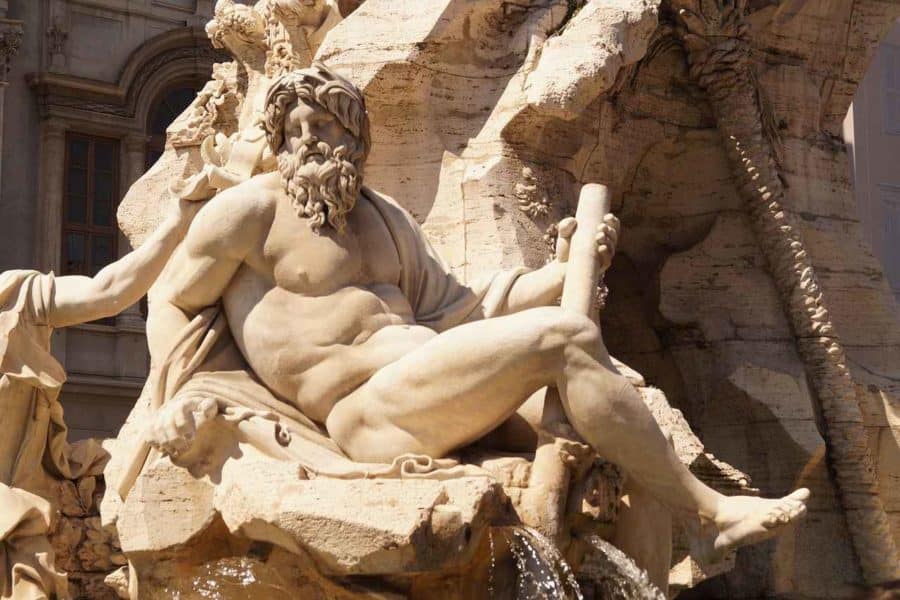When you walk through the narrow streets that surround it and then finally arrive on the square, it is almost impossible not to be entranced by the sight of the Piazza Navona fountain. Imposing and majestic, the fountain of the Four Rivers it stands out in front of the Church of Sant'Agnese in Agone designed by Borromini, reminding us that the layout of the entire square is the result of one of the most fascinating architectural interventions of the entire Baroque. But what do we really know about this incredible fountain created by Bernini?
A stone's throw from the restaurant and Piazza di Sant'Apollinare where we are, here is this masterpiece. Below, some fascinating details on its creation and its symbolism.
The history of the Piazza Navona fountain
As we all know, the Fountain of the Four Rivers is work of the sculptor and architect Gian Lorenzo Bernini, who created this incredible masterpiece commissioned by Pope Innocent X, who took care of the reorganization of the entire square in the Baroque Age. Specifically, the fountain was designed and built between July 1648 and June 1651, after the Pontiff set aside Borromini's project to accept that of his "rival" of the time. The entire history of the fountain is linked to this rivalry, so much so that popular belief has it that one of the sculptures was created with the hand turned to support the possible fall of the dome of the Church of Sant'Agnese, built by Borromini himself. This is a legend without any historical value, given that the work on the church only began in 1652, but the Romans like to tell this story, increasing the dispute between the two famous artists.
Fountain of the Four Rivers: description and symbolism
As already mentioned, the fountain it is located right in the center of the square, where a "drinker" was once located, i.e. a source of water for the horses that moved in the area, where a market once had a permanent base. Now the fountain in Piazza Navona has a completely different shape: one large elliptical tub in the center of which stands a marble sculptural group, on whose top it stands out an Egyptian obelisk, otherwise known as the “Agonal Obelisk” (this is a Roman copy found in the Circus of Maxentius on the Appian Way).
Specifically, the marble group is characterized by the presence of four giants, leaning on the sides of a travertine rock - which are none other than the allegories of the four largest rivers on Earth – at least according to the knowledge of the time -: the Nile, the Ganges, the Danube and the Rio de la Plata. In Bernini's creation, each of these figures is characterized by an explanatory detail. The Danube, for example, is represented in the act of indicating the coat of arms of the Pamphili family, to represent the power of Pope Innocent X, who commissioned the work. The Nile, instead, has the features of a giant who covers his face with a veil, thus referring to his origins unknown until the end of the 19th century. The Rio de la Plata he holds in his hand a sack overflowing with silver coins, symbolizing the incredible color of its waters, and the Ganges he holds an oar in his hands, as it is an extremely navigable river.

In addition to the giants, Bernini created other wonderful figures to accompany the composition. On the western side a horse is clearly visible coming out of the rocks with its front legs raised in the act of starting a wild gallop, while the eastern side is characterized by the depiction of a lion in the act of drinking at the foot of an African palm . And then all around there are also a dove, several dolphins, a dragon, a land serpent and a sea serpent.
But it is not only the incredible stylistic refinement that characterizes the fountain in Piazza Navona. What is surprising, in spite of other baroque creations, is Bernini's idea of keep the obelisk suspended in the air: this, in fact, does not rest on a real base, but on the edges of the underlying sculptural group, thus leaving a void that is truly spectacular. In the past, Bernini had already adopted this technique in the design of the Triton Fountain (1643), where he had achieved incredible success. We can therefore say that the Fountain of the Four Rivers is the second masterpiece created by Bernini in this sense. But, on the other hand, as you will discover, it is a masterpiece and that's it.



